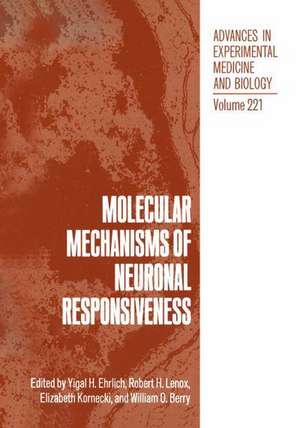Molecular Mechanisms of Neuronal Responsiveness: Advances in Experimental Medicine and Biology, cartea 221
Autor Yigal H. Ehrlich, Robert H. Lenox, Elizabeth Kornecki, William O. Berryen Limba Engleză Paperback – 18 mai 2012
Din seria Advances in Experimental Medicine and Biology
- 9%
 Preț: 719.56 lei
Preț: 719.56 lei - 5%
 Preț: 1095.03 lei
Preț: 1095.03 lei - 20%
 Preț: 691.93 lei
Preț: 691.93 lei - 5%
 Preț: 704.94 lei
Preț: 704.94 lei - 5%
 Preț: 704.94 lei
Preț: 704.94 lei - 5%
 Preț: 703.32 lei
Preț: 703.32 lei - 5%
 Preț: 704.22 lei
Preț: 704.22 lei - 5%
 Preț: 239.86 lei
Preț: 239.86 lei -
 Preț: 642.95 lei
Preț: 642.95 lei - 5%
 Preț: 820.42 lei
Preț: 820.42 lei - 5%
 Preț: 703.67 lei
Preț: 703.67 lei - 15%
 Preț: 629.45 lei
Preț: 629.45 lei - 15%
 Preț: 630.60 lei
Preț: 630.60 lei - 5%
 Preț: 1013.60 lei
Preț: 1013.60 lei - 5%
 Preț: 704.22 lei
Preț: 704.22 lei - 5%
 Preț: 705.14 lei
Preț: 705.14 lei - 20%
 Preț: 1142.10 lei
Preț: 1142.10 lei - 5%
 Preț: 1150.76 lei
Preț: 1150.76 lei - 18%
 Preț: 1100.97 lei
Preț: 1100.97 lei - 5%
 Preț: 1266.72 lei
Preț: 1266.72 lei - 5%
 Preț: 1145.01 lei
Preț: 1145.01 lei - 5%
 Preț: 1083.16 lei
Preț: 1083.16 lei - 18%
 Preț: 1104.69 lei
Preț: 1104.69 lei - 5%
 Preț: 1411.39 lei
Preț: 1411.39 lei - 20%
 Preț: 1026.46 lei
Preț: 1026.46 lei - 18%
 Preț: 930.42 lei
Preț: 930.42 lei - 5%
 Preț: 292.57 lei
Preț: 292.57 lei - 18%
 Preț: 941.47 lei
Preț: 941.47 lei - 18%
 Preț: 1214.88 lei
Preț: 1214.88 lei - 5%
 Preț: 1210.77 lei
Preț: 1210.77 lei - 5%
 Preț: 1270.49 lei
Preț: 1270.49 lei - 5%
 Preț: 1083.51 lei
Preț: 1083.51 lei - 18%
 Preț: 1113.70 lei
Preț: 1113.70 lei - 5%
 Preț: 1145.52 lei
Preț: 1145.52 lei - 5%
 Preț: 1394.53 lei
Preț: 1394.53 lei - 5%
 Preț: 1283.60 lei
Preț: 1283.60 lei - 18%
 Preț: 1393.77 lei
Preț: 1393.77 lei - 18%
 Preț: 1402.55 lei
Preț: 1402.55 lei - 24%
 Preț: 806.15 lei
Preț: 806.15 lei - 18%
 Preț: 1222.29 lei
Preț: 1222.29 lei - 5%
 Preț: 1405.29 lei
Preț: 1405.29 lei - 5%
 Preț: 1591.34 lei
Preț: 1591.34 lei - 5%
 Preț: 1283.09 lei
Preț: 1283.09 lei - 18%
 Preț: 1105.93 lei
Preț: 1105.93 lei - 5%
 Preț: 1079.03 lei
Preț: 1079.03 lei - 15%
 Preț: 638.91 lei
Preț: 638.91 lei - 5%
 Preț: 1079.03 lei
Preț: 1079.03 lei - 18%
 Preț: 929.84 lei
Preț: 929.84 lei
Preț: 405.29 lei
Nou
Puncte Express: 608
Preț estimativ în valută:
77.59€ • 79.79$ • 64.37£
77.59€ • 79.79$ • 64.37£
Carte tipărită la comandă
Livrare economică 19 februarie-05 martie
Preluare comenzi: 021 569.72.76
Specificații
ISBN-13: 9781468476200
ISBN-10: 1468476203
Pagini: 576
Ilustrații: X, 563 p. 107 illus.
Dimensiuni: 178 x 254 x 30 mm
Greutate: 0.98 kg
Ediția:Softcover reprint of the original 1st ed. 1987
Editura: Springer Us
Colecția Springer
Seria Advances in Experimental Medicine and Biology
Locul publicării:New York, NY, United States
ISBN-10: 1468476203
Pagini: 576
Ilustrații: X, 563 p. 107 illus.
Dimensiuni: 178 x 254 x 30 mm
Greutate: 0.98 kg
Ediția:Softcover reprint of the original 1st ed. 1987
Editura: Springer Us
Colecția Springer
Seria Advances in Experimental Medicine and Biology
Locul publicării:New York, NY, United States
Public țintă
ResearchCuprins
Section I Signal Transduction and Stimulus-Response Coupling.- Further Studies on Depolarization Release Coupling in Squid Giant Synapse.- Temporal and Spatial Events in the Calcium Messenger System.- Potassium Channels in Mouse Spinal Cord Cells.- Polyunsaturated Fatty Acids and Inositol Phospholipids at the Synapse in Neuronal Responsiveness.- Receptor-Mediated Phosphoinositide Metabolism.- Muscarinic Acetylcholine Receptor-Linked Inositide Cycle in the Central Nervous System.- The Role of GTP-Binding Proteins in Receptor Activation of Phospholipase C.- Molecular Geometries and Steric Energies of Phorbol 10, 11-Diacetate and 1, 2-Diacetylglycerol Molecules.- A Model of the Light Dependent Regulation of Retinal Rod Phosphodiesterase, Guanylate Cyclase and the Cation Flux.- Regulation of Neuronal Adenylate Cyclase.- Synapsin I, A Phosphoprotein Associated with Synaptic Vesicles: Possible Role in Regulation of Neurotransmitter Release.- Regulation of the Phosphorylation and Dephosphorylation of a 96,000 Dalton Phosphoprotein (P96) in Intact Synaptosomes.- Phosphorylation and Dephosphorylation of Neurofilament Proteins in Retinal Ganglion Cell Neurons In Vivo.- Extracellular Protein Phosphorylation in Neuronal Responsiveness and Adaptation.- Expression of Rat Brain Excitatory Amino Acid Receptors in Xenopus Oocytes.- Tyrosine Availability: A Presynaptic Factor Controlling Catecholamine Release.- Molecular Mechanisms Controlling Norepinephrine-Mediated Release of Serotonin from Rat Pineal Glands.- Molecular Mechanisms of Acidic Amino Acid Release From Mossy Fiber Terminals of Rat Cerebellum.- Section II Neuronal Adaptation and Synaptic Plasticity.- Molecular Mechanisms of ?-Adrenergic Receptor Desensitization.- Long-Term Synergistic Regulation of Ionic Channels byC-Kinase and Ca++/CaM-Type II Kinase.- A Possible Second Messenger System for the Production of Long-Term Changes in Synapses.- Protein F1 and Protein Kinase C May Regulate the Persistence, Not the Initiation, of Synaptic Potentiation in the Hippocampus.- Electrophysiologic Responses and Adenylate Cyclase Activities of Mouse Spinal Cord-Dorsal Root Ganglion Expiants Rendered Tolerant by Chronic Exposure to Morphine or Pertussis Toxin.- Biochemical and Functional Interactions of a Selective Kappa Opioid Agonist with Calcium.- Long-Term Inhibition of Kindled Seizures by Chemical and Electrophysiological Techniques: Insights into the Kindling Process?.- Altered Reactivity of the Rat Adrenal Medulla Following Periods of Chronic Stress.- Chemoreception: Paramecium as a Receptor Cell.- Reduction of Dopamine Receptor Activity Differentially Alters Striatal Neuropeptide mRNA Levels.- Section III Behavioral and Clinical Implications.- B-50 Phosphorylation, Protein Kinase C and the Induction of Excessive Grooming Behavior in the Rat.- Molecular Mechanisms of Neuronal Excitability: Possible Involvement of CaM Kinase II in Seizure Activity.- Cytoskeletal Pathology in Neurodegenerative Diseases.- Modulation of Schwann Cell Antigens During Wallerian Degeneration and Regeneration in the Adult, Mammalian Peripheral Nerve.- A Physiological Role of the Benzodiazepine/GABA Receptor-Chloride Ionophore Complex in Stress.- Interactions of the Alkyl-Ether-Phospholipid, Platelet Activating Factor (PAF) with Platelets, Neural Cells, and the Psychotropic Drugs Triazolobenzodiazepines.- The Serotonin-Norepinephrine Link Hypothesis of Affective Disorders: Receptor-Receptor Interactions in Brain.- “Substance M”, A Serotonin Modulator Candidate from Human Urine?.- Role of Receptor Coupling toPhosphoinositide Metabolism in the Therapeutic Action of Lithium.- Agonist-Stimulation of Cerebral Phosphoinositide Turnover Following Long-Term Treatment with Antidepresants.- A Possible Role for Thyrotropin Releasing Hormone (TRH) in Antidepressant Treatment.







